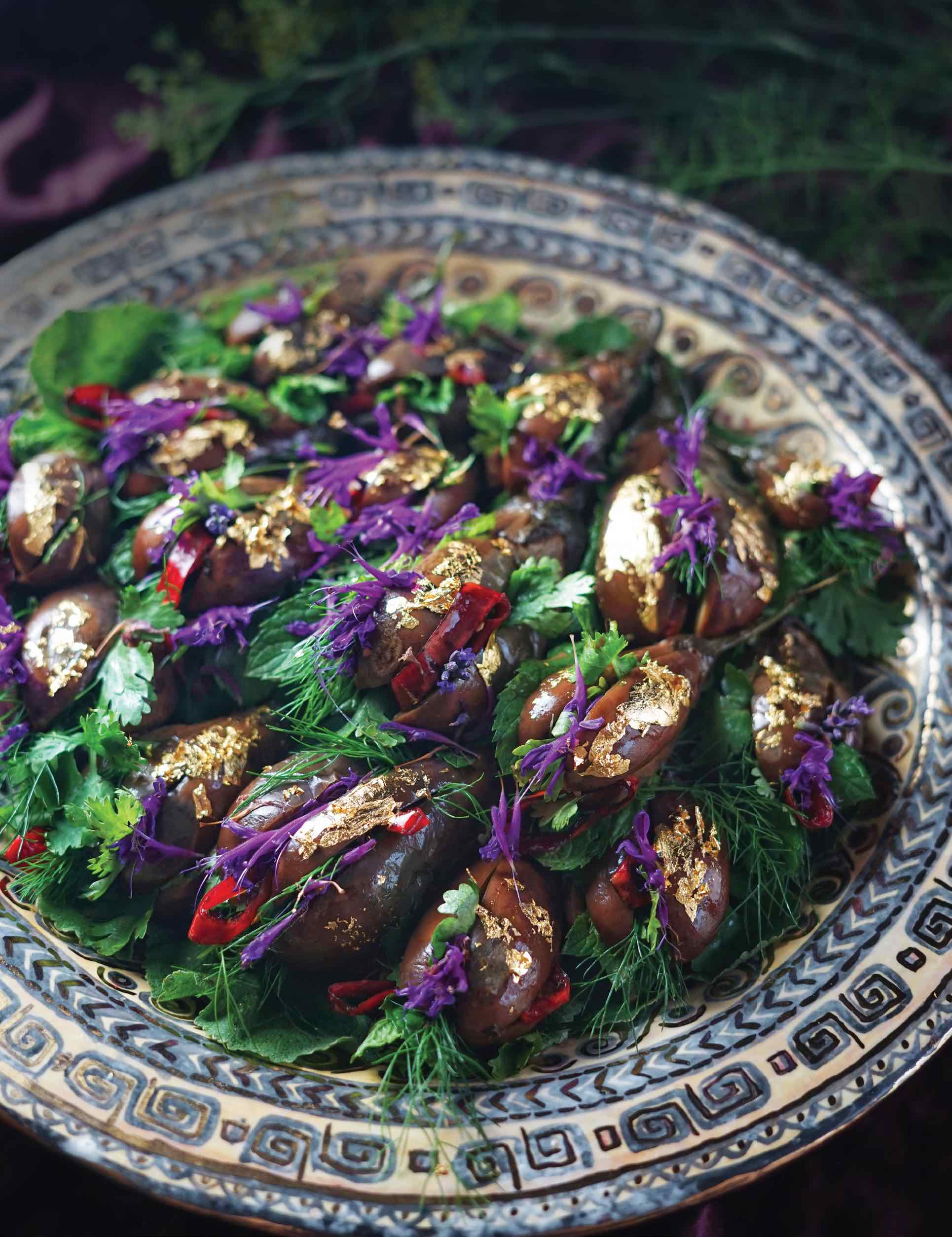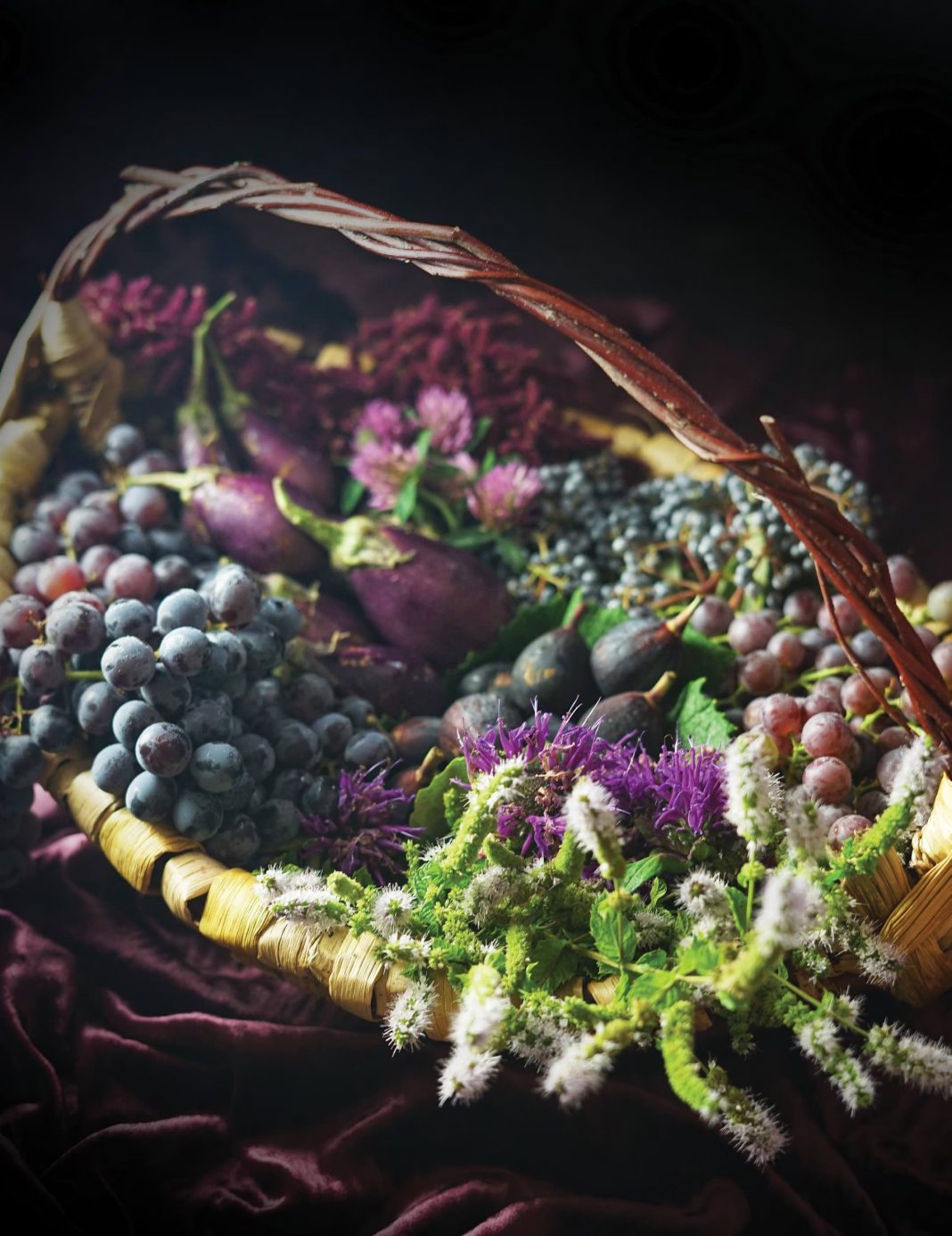Today you most often hear decadent as a mouthwatering adjective for a rich dessert or perhaps a holiday feast. It conjures up lavish, indulgent foods—often expensive, extravagant, or prolific. Picture an ancient Roman feast hall, filled with purple-clad generals and emperors dining on exotic and aromatic foods served from glittering golden platters or highly decorated ceramic dishes. The air is heavy with the scent of fresh rose petals and saffron, and the table is piled high with more food than you and the other dinner guests could possibly eat, and absolutely dripping with gem-like fresh fruit. The wine keeps flowing as you indulge in the sensual feast laid before you well into the night …
It may sound like a beautiful daydream, but such decadence has a dark side. The clue lies within the word’s etymology; it comes from the same root as decay, and the other definition of decadence is the decay or degeneration of society or morals, usually due to affluence or gluttony. According to the Merriam-Webster dictionary:
At some point, this word that described the excesses associated with social and moral decay (“a decadent society”) came to refer more to the excess than to the decay. This slight shift in meaning gave decadent the use defined as “characterized by self-indulgence,” which is how treating yourself to that piece of chocolate cake came to seem less like decaying and more like luxury.
Perhaps decadence as we know it today carries with it a warning: Indulge and enjoy, but be cautious not to let the temptation of sensual pleasures divide you from your scruples. Let’s look to ancient Rome as a cautionary tale. As Diane Ackerman writes in A Natural History of the Senses:
Romans adored the voluptuous feel of food: the sting of pepper, the pleasure-pain of sweet-and-sour dishes, the smoldery sexiness of curries, the piquancy of delicate and rare animals, whose exotic lives they could contemplate as they devoured them, sauces that reminded them of the smells and tastes of lovemaking. It was a time of fabulous, fattening wealth and dangerous, killing poverty… the Romans amused themselves with the lavishness of a people completely untainted by annoying notions of guilt. In their culture, pleasure glistened as a good in itself, a positive achievement, nothing to repent.
There is a reason that ancient Roman art is a huge part of Western art history; the sheer wealth of the upper classes afforded the luxury of art, among other sensual pleasures. Roman society was also likely the source of our cultural association of the color purple with royalty and riches. Tyrian purple, a sort of dark purple-red, was a popular color for the togas of the most wealthy. Can’t you just picture their extravagant feasts now? Perhaps Ackerman can assist your imagination once again:
Romans staged all-night dinner parties and vied with one another in the creation of unusual and ingenious dishes. … Mechanical devices might lower acrobats from the ceiling along with the next course … Slaves brought garlands of flowers to drape over the diners, and rubbed their bodies with perfumed unguents to relax them. The floor might be knee-deep in rose petals … Slaves blew exotic scents through pipes into the room, and sprinkled the diners with heavy, musky animal perfumes like civet and ambergris. Sometimes the food itself squirted saffron or rose water or some other delicacy into the diner’s face, or birds flew out of it, or it turned out to be inedible (because it was made of pure gold.)
When I first read this passage, I was entranced: such sensual creativity! What a delight it would be to wade through a hallway of rose petals up to my knee, or to taste luxurious perfumed sweets that were full of strange surprises! In the margin, I jotted a note: “Oh, to be in ancient Rome!” Then the reality of the utter decadence of that society struck me and I followed it up on the next page with an “Okay, maybe not…” as I considered just how many slaves it would take to fill up a hall with knee-deep roses for an evening, or learned of the Romans’ penchant for forcing those below them to perform sexually for their amusement, or even fight each other to the death right on the dinner table. Even that beautiful Tyrian purple came with a shocking discovery: The reason only those of the highest status could afford it was because the dye came from a couple of species of sea snails in the murex family, which had to be hand-extracted. It took tens of thousands of snails to dye just one toga.
Delight in the sensual pleasures described above soon turned to disgust at the sheer disparity in wealth and morality. In fact, many believe that it was this decadent lifestyle that led to the downfall of the Roman empire. As Ackerman continues, “Small wonder Christianity arose as a slave-class movement, emphasizing self-denial, restraint, the poor inheriting the earth, a rich and free life after death, and the ultimate punishment of the luxury-loving rich in the external tortures of hell.”
The pleasures of the body were vilified, all temptations seen as a road for the damned. As the pendulum swung in the opposite direction, the denial of pleasure became an integral part of the Christian creed of salvation. It’s an understandable reaction, to be sure. And yet, let us remember that pleasure itself is not the sign of a societal downfall, nor is it something to deny ourselves completely.
Filling our lives with sensual pleasures is part of what makes life so delightful! It’s why we are drawn to chewy breads or silky sauces, the bright pops of rich red and purple foods that subconsciously whisper of ripeness and fertility, the many varied flavors of spices from near and far, the fragrance of something delicious baking, even the sizzle of fresh fruit baking into a sweet end to a lavish meal. Today when we don our responsibly sourced purple gowns and cook up a feast to enjoy with friends, it need not be a selfish exploitation of others; it can simply be a celebration, taking joy in enjoying the decadence of good food in the company of friends. The gorgeous purple tones in the vegetarian delights that follow were obtained naturally from the earth, no snails needed.
Perhaps you’d like to join me for a decadent feast loosely inspired by ancient Roman recipes but modernized to be not only absolutely delicious but in line with the values of generosity and respect. Don your purple garb, my dears, and let us reclaim the delightful decadence of this feast together!

GILDED MINI EGGPLANTS WITH BLACK GARLIC, CILANTRO, AND WILD HERBS
Eggplants come in such a beautiful array of amethyst shades, from the deepest plum purples to light lavenders. I love using whole mini eggplants for this recipe, but you can also just slice a large eggplant into half-inch slices and proceed. I’ve decorated mine with edible gold leaf; an embellishment that makes them extra festive, but is entirely optional. This recipe is also easily made vegan! Adapted from a recipe by Yotam Ottolenghi.
Makes about 16 mini eggplants to serve 8 as a side.
16 mini eggplants (or 2 medium-large)
4 tablespoons olive oil, divided
2 cloves garlic, minced
¼ teaspoon salt
¼ teaspoon freshly cracked black pepper
Pinch dried and ground cumin
Pinch dried and ground cinnamon
2 red chilies, sliced thinly
1 cup mixed fresh herbs—wild fennel, wild mint, and cilantro are my favorites!
Edible gold leaf, optional
Sauce:
¼ teaspoon salt
1 tablespoon olive oil
1/2 cup vegan yogurt
4 to 6 cloves black garlic
2 teaspoons lemon juice
Directions:
Wash the eggplants, then pat dry. Slit them lengthwise into 4 or 6 wedge-shaped segments, cutting from the bottom and stopping before you reach the stalk so the pieces don’t separate completely.
Mix the minced garlic with 2 tablespoons olive oil, salt, pepper, cumin, and cinnamon. Rub this mixture gently on the insides of the eggplants.
Heat 2 tablespoons oil in a frying pan over medium heat, then add the eggplant. Turn the heat to low and put a lid on the pan.
Continue cooking, gently turning the eggplants every few minutes so they cook evenly. Once they are soft but not mushy, remove them from the pan and move to a plate.
Heat the pan back up to medium heat and cook the red chili slices until they are crispy, then drain on a paper towel.
Add the sauce ingredients to a food processor and blend until smooth. Holding the top of one of the cooked eggplants in one hand, add a spoonful of sauce to the very middle between the wedges.
Tuck in the red chilies and fresh herbs, then lay on the platter. Fill and decorate each mini eggplant, then garnish with edible gold leaf.

































